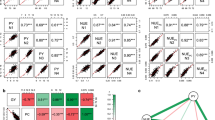Abstract
While new lines developed by CIMMYT under intermediate levels ofnitrogen are more nitrogen efficient than older lines, it is not knownwhether this method of selection is the most efficient. Two lines with highN up-take efficiency (UPE) were crossed to two lines with high N utilizationefficiency (UTE). Their progenies were visually selected for superioragronomic type from the F2 till the F6 under each of fiveselection regimes. These were: always under low N (0 added) (LN), alwaysunder medium N (150 kg N ha-1 added) (MN), always under highN (300 kg N ha-1 added) (HN), alternating between low and highN starting with low N in the F2 (ALN) and alternating between highand low N starting with high N in the F2 (AHN). The resultingadvanced lines (F8) were tested in replicated yield trials under low,medium, and high levels of added N on an N deficient soil. The AHNselection regime resulted in the highest yields at intermediate and high Nlevels. The lowest yields occurred for ALN. Harvest Index (HI) did notchange. Hence all effects on yield were the result of changes in biomass.Under low N all selection regimes showed progress in yield due to animproved biomass and HI, but with no differences among regimes. UPEexpressed a higher correlation with yield and biomass than UTE under alllevels of N.
Similar content being viewed by others
References
Aggarwal, P.K., M.J. Kropff, K.G. Cassman & H.F.M. ten Berge, 1997. Simulating genotypicstrategies for increasing rice yield potential in irrigated, tropical environments. Field Crops Research 51: 5–17.
Austin, R.B., M.A. Ford, C.L. Morgan & D. Yeoman, 1993. Old and modern wheat cultivars compared tobroadbalk wheat experiment. Eur J Agron 2(2): 141–147.
Campbell, C.A., D.R. Cameron, W. Nicholaichuk, H.R. Davison, 1977. Effect of fertilizer N and soil moisture on growth, N content, and moisture use by spring wheat. Can J Soil Sci 57: 289–310.
CAST (Council for Agricultural Science and Technology), 1985. Agricultural andground-water quality. Report no. 103. Council for Agricultural Science and Technology, Ames, IA.
Clarke, J.M.,C.A. Campbell, H.W. Cutforth, R.M. DePauw & G.E. Wikleman, 1990. Nitrogen and phosphorus uptake, translocation and utilization efficiency of wheat in relation to environment and cultivar yield and protein levels. Can J Plant Sci 70: 965–977.
Dhugga, K.S. & J.G. Waines, 1989. Analysis of nitrogen accumulation and use in bread anddurum wheat. Crop Sci 29: 1232–1239.
Fischer, R.A., 1981. Optimizing the use of water and nitrogenthrough breeding of crops. Plant and Soil 58: 249–278.
Fischer, R.A., G.N. Howe & Z. Ibrahim, 1993.Irrigated spring wheat and timing and amount of nitrogen fertilizer. I. Grain yield and protein content. Field Crops Research 33: 37–56.
Fischer, R.A. & P.C. Wall, 1976. Wheat breeding in Mexico and yield increases. The Journalof the Australian Institute of Agricultural Science. 42(3): 139–148.
Gauer, L.E., C.A. Grant, D.T. Gehl & L.D. Bailey, 1992. Effects of nitrogen fertilization on grain protein content, nitrogen uptake, and nitrogen use efficiency of six spring wheat (Triticum aestivum L.) cultivars, in relation to estimated moisture supply. Can J Plant Sci 72: 235–241.
Jain, N.K., B.A. Krantz, K.B. Bains, R.B.L. Bhardwaj, S. Bhattacharya, G.S. Gill, K.P. Gupta, M.K. Moolani, I.R. Morabad, U.J. Patel, M.K. Reddy, K.S. Sandhu, A.K. Sharma, K.C. Sharma, G.S. Shekhawat, M. Singh, R.R. Singh, M.M.P. Srivastava & B.C. Wright, 1975. Response of dwarf wheat varieties to nitrogen. pp.11–23. In: A.M. Wadhwani & Rajinder Singh (Ed.), Agronomy of Dwarf Wheats - Summary of Investigations of the All-India Co-ordinated Wheat Improvement Project. Indian Council of Agricultural Research, New Delhi.
Keeney, D.R., 1982.Nitrogen management for maximum efficiency and minimum pollution. In: F.J. Stevenson (Ed.) Nitrogen in agricultural soils, pp. 605–649. Agron. Monogr. 22. ASA, CSSA and SSSA, Madison, WI.
Moll, R.H., E.J. Kamprath, W.A. Jackson, 1982. Analysis and interpretation of factors which contribute to efficiency of nitrogen utilization. Agron J 74: 562–564.
Ortiz-Monasterio, R.J.I., K.D. Sayre, S. Rajaram & M. McMahon, 1997. GeneticProgress in wheat yield and nitrogen use efficiency under four N Rates. Crop Sci 37(3): 898–904.
VanSanford, D.A. & C.T. MacKown, 1986. Variation in nitrogen use efficiency among soft red winter wheat genotypes. Theor Appl Genet 72: 158–163.
Author information
Authors and Affiliations
Rights and permissions
About this article
Cite this article
Van Ginkel, M., Ortiz-Monasterio, I., Trethowan, R. et al. Methodology for selecting segregating populations for improved N-use efficiency in bread wheat. Euphytica 119, 223–230 (2001). https://doi.org/10.1023/A:1017533619566
Issue Date:
DOI: https://doi.org/10.1023/A:1017533619566




